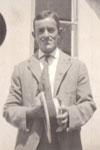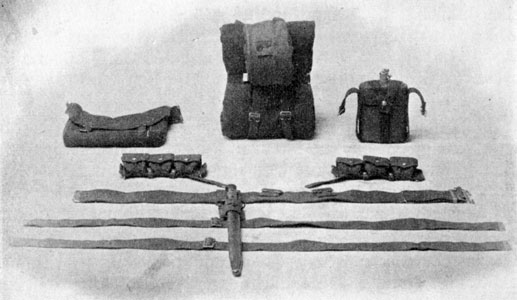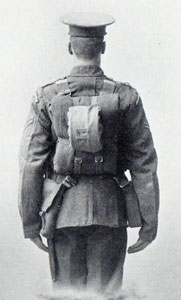Web Equipment Pattern 1908 - Territorial Force Variants
Introduction
 This is William Pierrepont Wise, an American who acted as the travelling salesman for the Mills Woven Cartridge Belt Company’s U.K. subsidiary. This photograph, published here for the first time, was taken on 20 July, 1901, on board the S.S. Sequioa, as he was leaving Boston for his first trip to the U.K. Virtually single-handedly, he managed to get the War Office to trial the new Web Equipment that the U.K. subsidiary had developed. He then oversaw the trials in India and, after several years of effort, eventually persuaded the War Office to adopt Pattern 1908 Web Infantry Equipment. He was M.E.Co.’s first Managing Director when it became an English Company in 1906.
This is William Pierrepont Wise, an American who acted as the travelling salesman for the Mills Woven Cartridge Belt Company’s U.K. subsidiary. This photograph, published here for the first time, was taken on 20 July, 1901, on board the S.S. Sequioa, as he was leaving Boston for his first trip to the U.K. Virtually single-handedly, he managed to get the War Office to trial the new Web Equipment that the U.K. subsidiary had developed. He then oversaw the trials in India and, after several years of effort, eventually persuaded the War Office to adopt Pattern 1908 Web Infantry Equipment. He was M.E.Co.’s first Managing Director when it became an English Company in 1906.
The Territorial Force, newly formed in 1908, was equipped with a variety of equipment, both regulation and commercial. By the 20th Century, their accoutrements were largely a mixture of Valise Equipment of Patterns 1882 and 1888, as well as commercial derivatives of these. Once Patt. 1908 was on issue to the Regular Army, surplus Patt. 1903 Bandolier Equipment became available for the T.F., though its pockets meant only units with charger-loading weapons could make use of B.E.
The Mills Equipment Company, established as a U.K. company only in 1906, were very keen to extend their market and almost as soon as their Pattern 1908 was approved, Wise must have recognised the huge potential market represented by the Territorial Force, the infantry component of which comprised 201 battalions in 1908. By 1 June 1908, the force had attracted less than 145,000 recruits. Despite considerable efforts to promote the new organisation to the former auxiliary institutions, less than 40 per cent of all existing auxiliaries transferred into it.Mindful of the T.F’s. budget constraints, Mills therefore developed a “cheap and cheerful” variant of Patt. ’08 W.E., which would allow the more well-off units to consider a move to web equipment. The simplest T.F. set was 39% cheaper than the equivalent Regular set. Using the 1920 Priced Vocabulary, the components described below, for a standard set of Patt. ’08, with Pack, cost 23s 5½d, whereas the T.A. version, with Great Coat Carrier was only 14s 3d – over 9 shillings cheaper.
Necessarily, this meant a start was made with the City and County of London Territorial Associations. As time went on, some of the surrounding counties were able to follow suit. The financial factor meant this tended to be confined to industrial areas, where local worthies could help in financing moves to re-equip.
A contemporary publication used the nomenclature of “Modified War Office Pattern Equipment, specially adapted for Territorials”. KW will term this – more simply – as Pattern 1908 W.E. (T.F. Pattern).

 For M.E.Co., the process was very simple, requiring a modification to the Braces, Cartridge Carriers, Haversacks, Frogs, Water Bottle Carriers and an alternative to the Pack, which was the most expensive item. The M.E.Co. Golden Jubilee book illustrates the basic set, comprising these modified items. By omitting various design features on the other articles, cheaper alternatives could be offered. With very few exceptions, these never appeared in Section 1A of the Priced Vocabulary, so there are no official nomenclatures.
For M.E.Co., the process was very simple, requiring a modification to the Braces, Cartridge Carriers, Haversacks, Frogs, Water Bottle Carriers and an alternative to the Pack, which was the most expensive item. The M.E.Co. Golden Jubilee book illustrates the basic set, comprising these modified items. By omitting various design features on the other articles, cheaper alternatives could be offered. With very few exceptions, these never appeared in Section 1A of the Priced Vocabulary, so there are no official nomenclatures.
Those below follow the normal forms, “(T.F. pattern)” being added where a discrete nomenclature is needed, to distinguish from those articles issued to the Regulars. A further distinction is necessary for Cartridge Carriers, so “CL” and “NCL” have been added, as it is necessary to distinguish tapered pockets (for charger loaded ammunition) from box pockets containing one packet, with loops for 5 loose rounds or possibly two packets of ammunition. Not all the permutations are known, but on the evidence seen so far, Mills were clearly keen to cater to the customer’s requirements, whatever they might have been.